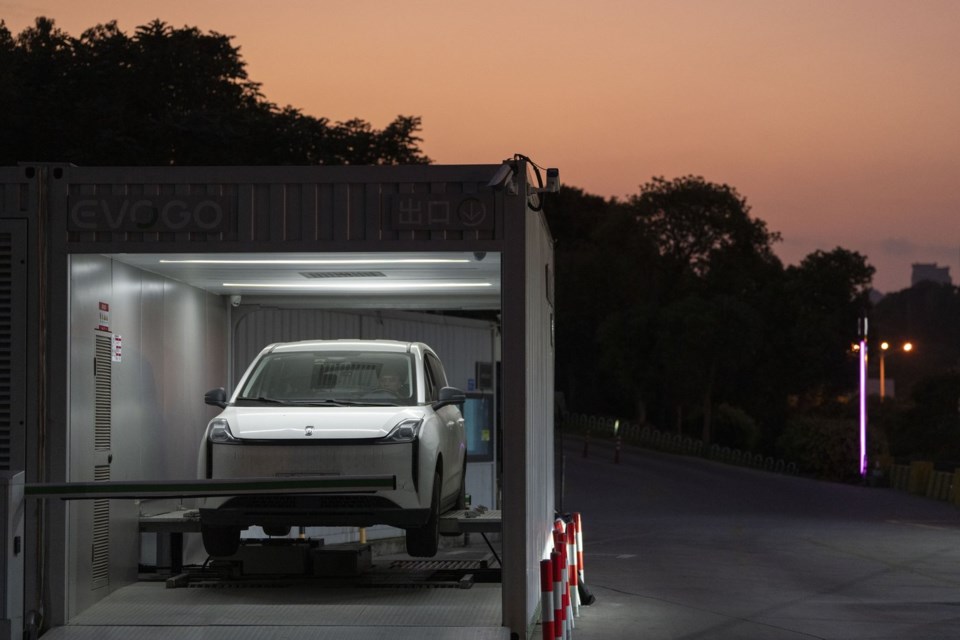XIAMEN, China (AP) — The for electric vehicles said Wednesday it will get into battery swapping in China in a big way starting next year.
The idea behind battery swapping is to refuel quickly, similar to filling a conventional car with gas. Instead of waiting for the batteries to recharge, one swaps out the old ones with a block of fresh ones at a swap station. An EV driver pulls into a swapping station, and automated technology exchanges the low battery for a fully-charged one the station has available.
China-based CATL announced plans to open 1,000 swap stations next year in China, including in Hong Kong and Macao, with a long-term goal of 10,000 stations built with partners. If the company follows through, it could rival that has opened more than 2,700 stations and has plans for at least 5,000.
Nothing on that scale exists elsewhere in the world, though Nio has about 60 swap stations in northern Europe. Such a large investment is possible in China, where government support has transformed the world's largest auto market into a heavily electric one and made the country .
“By 2030, battery swapping, home charging, and public charging stations will share the market,” Robin Zeng, the CEO of CATL, predicted at a splashy presentation in southeast China's Fujian province, where CATL is based. He appealed to corporate partners to work together to "build more convenient, more economical and safer services for customers, promoting a brand-new way of life.”
Battery swapping faces hurdles. It requires a standardization of the battery pack so the swap stations can handle it, and most EVs have their own configuration. An electric vehicle has to be equipped with the right technology in order to use a battery swapping station, and not many EV models around the world currently allow for swapping.
Conversely, an electric car can use any charging station in China because all use a common plug, and fast-charging technology is reducing the time for a recharge.
Jing Yang, a Fitch Ratings director who focuses on China’s auto and renewable energy sectors, said automakers may be concerned that adopting a standard battery pack could cede too much control of their supply chain to others.
Electric car manufacturers have many changing specifications to stay on top of and invest in as the EV market evolves, making new technology a hard sell. It is difficult to get automakers to buy into less feasible infrastructure if EV adoption in a region is still relatively low.
But some may want to test the waters to see if battery swapping can improve sales, and doing so with CATL or Nio could reduce the cost, she said. That's because a driver wouldn't have to own the battery, which is currently the most expensive part of an EV.
China auto market analyst Lei Xing believes that swapping can complement the country's well-developed charging network. “I don’t see it becoming mainstream, but I do see it becoming a key part of that infrastructure landscape,” he said.
Michael Davidson, a renewable energy expert at the University of California, San Diego, believes that charging will dominate "and maybe there’ll be some battery swapping options mixed in there.”
The concept has proven easier to implement with fleet vehicles — taxis, buses and commercial trucks — that have a standard model and, in some cases, stick to set routes. CATL, which launched a small pilot project two years ago aimed at taxis, will start its rollout with fleets and expand to individual car owners later, said Zhang Kai, the deputy president of CATL's battery swapping subsidiary.
Swapping is still faster than fast-charging. The CATL station, branded EVOGO, can change a battery pack in 100 seconds, said Yang Jun, the CEO of the subsidiary. Time is money for taxi and truck drivers, Lei said.
Wang Wubing, a driver at China’s popular Didi ride-hailing service, said at an EVOGO station in the city of Xiamen that he swaps batteries to save time so he can pick up more customers. But it is more expensive than charging.
In the U.S., battery swapping made headlines nearly two decades ago with the startup Better Place, which later shut down. Now, companies such as Ample have reinvented the technology, also starting with the ride-hailing market. Uber and Lyft drivers that own electric cars want to spend time on the road and earning money instead of waiting even for the fastest EV charge. Ample says its swaps take just 5 minutes.
Both CATL and Nio have announced agreements with automakers to use their swap stations. The question is whether enough automakers and drivers adopt it to raise use of the stations to a profitable level.
___
Moritsugu reported from Beijing. Associated Press video producer Olivia Zhang and researcher Yu Bing contributed.
___
The Associated Press’ climate and environmental coverage receives financial support from multiple private foundations. AP is solely responsible for all content. Find AP’s for working with philanthropies, a list of supporters and funded coverage areas at .
Ken Moritsugu And Ng Han Guan, The Associated Press


